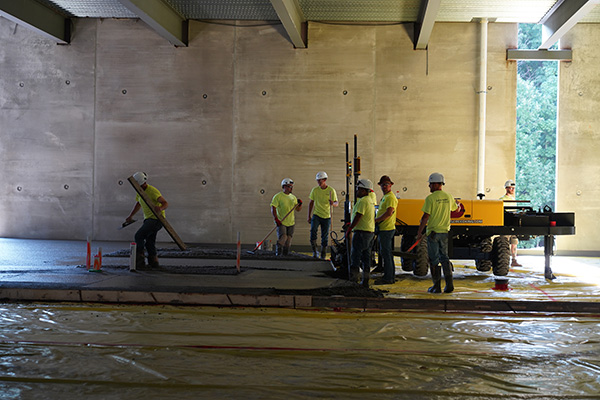Design-Build minimizes uncertainty and leads to quicker and better outcomes.
Design-build is among the fastest-growing and most used project delivery methods in the United States.1 According to FMI, design-build spending is projected to grow by 22.5% from 2022 to 2026.2 Companies increasingly prefer this method for their industrial construction projects, as it helps make the most of existing spaces and tailor buildings to specific needs. The core of this approach lies in its single contract for both design and construction. This process minimizes uncertainty and leads to quicker and better outcomes, making industrial projects more cost-effective.
However, design-build is more than a contract—it’s a collaborative mindset. For maximum effectiveness, all parties must adopt a unified perspective. In this method, the architect and contractor work together through all phases of the project. The benefits are significant: more accurate estimating, cost savings, early designer-contractor collaboration and faster project delivery.

At a time of high inflation and interest rates, every project is interested in making the most of its budget. The integrated approach inherent in design-build reaps cost benefits. According to the Construction Industry Institute, design-build projects are 1.9% less expensive than construction manager at risk projects on a cost-per-square-foot basis.3 With many industrial project costs in the hundreds of thousands or even millions, a one or two-percent cost savings is significant.
Unlike traditional construction methods where final costs only become apparent after design completion, design-build enables contractors to estimate accurately during the design phase. This allows clients to make informed decisions about design elements based on budget considerations. Design-build also incorporates budget checkpoints to ensure costs do not exceed expectations.
Additionally, the close collaboration between designers and builders means that the team can find cost-effective solutions without compromising the project’s quality or functionality. Builders are at the table during the design phase, so materials are sourced earlier and more cost-effectively. Construction industry experts say material costs will remain elevated when compared to pre-pandemic levels, with an average jump of 19%4, so using a method that leads to material cost savings is a wise move.
Logistics and accountability issues can make or break a project. Studies show that teams that collaborate and communicate more effectively can improve productivity by 20-25%.5 In fact, construction companies attribute nearly 50% of rework to poor communications, collaboration, and data.6 Design-build improves project outcomes because it has one point of accountability. When you align the architect and contractor with a contractual arrangement, decision-making is more efficient; for example, change orders become much less likely.
Design-build streamlines project processes by bringing design and construction under one contract umbrella. From the start, the architect and contractor work together to provide unified project design recommendations to fit the client’s schedule and budget. With the design-build process, the designers collaborate with the builder on constructability details, materials, and sequencing of the work. This helps eliminate possible coordination issues or schedule delays during construction, ultimately saving time and money. A good design build team also holds each other accountable to balance good quality with price.
Delays seem to have become par for the course in today’s current environment, but you can expect faster project delivery with design-build. From design through finish, design-build projects are completed 61% faster than construction manager at risk and 102% faster than design-bid-build.7 Concurrent design and construction work occurs when architects and builders are able to work together from the project’s outset. This saves time, like in the case of permitting. Rather than waiting for everything to be finished as is the case with design-bid-build process, with design-build permitting occurs as sections of the design are completed. This can allow construction to begin sooner.
Teams can also better manage schedules by prioritizing design and pricing for equipment with long production timeframes and ordering those items early on. They coordinate the design details around critical materials and equipment and approve those details when finished.
The design-build approach offers a more integrated, efficient, and collaborative way to execute industrial construction projects. This provides clients with streamlined processes, cost savings, and enhanced project outcomes. Many clients have come to prefer the design-build delivery method for its speed, collaboration, and transparency.
When done right, everyone involved is working together towards the same goal, which minimizes risk for the owner. That early collaboration between designers and the builder allows the owner to make quick, well-informed decisions with input from all the involved parties. It’s no wonder design-build has experienced such substantial growth as a method of project delivery.
As you look to your next industrial construction project, consider using design-build to ensure your project runs smoothly and maximizes budget.

Erik Dillon is Vice President at Riley Construction in Kenosha, Wisconsin.
1 https://dbia.org/impact/
2 https://www.esri.com/en-us/industries/blog/articles/the-importance-of-gis-for-design-build-observations-from-the-dbia-conference/#:~:text=Total%20growth%20in%20design%2Dbuild,22.5%25%20from%202022%20to%202026.&text=The%20uptick%20in%20acceptance%20of,valued%20for%20its%20collaborative%20nature.
3 https://www.enr.com/articles/45839-conference-reaffirms-strength-of-design-build-delivery#:~:text=The%20updated%20study%20examined%20a,and%203.8%25%20less%20than%20DBB.
4 https://www.constructiondive.com/news/falling-material-prices-expected-reverse-course/651744/
5 https://www.linkedin.com/pulse/statistics-why-effective-communication-important-/
6 https://www.autodesk.com/blogs/construction/construction-disconnected-fmi-report/
7 https://dbia.org/new-research-shows-design-build-continues-to-deliver-project-most-efficiently/
Scott Ellyson, CEO of East West Manufacturing, brings decades of global manufacturing and supply chain leadership to the conversation. In this episode, he shares practical insights on scaling operations, navigating complexity, and building resilient manufacturing networks in an increasingly connected world.